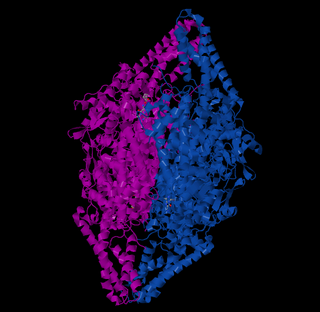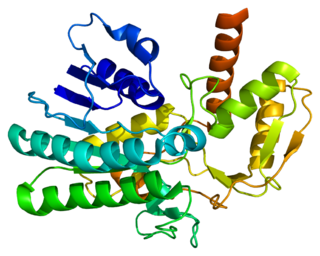
Histidinemia is a rare autosomal recessive metabolic disorder caused by a deficiency of the enzyme histidase. Histidase is needed for the metabolism of the amino acid histidine. Although originally thought to be linked to multiple developmental disorders histidinemia is now accepted as a relatively benign disorder, leading to a reduction in the prevalence of neonatal screening procedures.

Porphobilinogen deaminase (hydroxymethylbilane synthase, or uroporphyrinogen I synthase) is an enzyme (EC 2.5.1.61) that in humans is encoded by the HMBS gene. Porphobilinogen deaminase is involved in the third step of the heme biosynthetic pathway. It catalyzes the head to tail condensation of four porphobilinogen molecules into the linear hydroxymethylbilane while releasing four ammonia molecules:

Cystathionine-β-synthase, also known as CBS, is an enzyme (EC 4.2.1.22) that in humans is encoded by the CBS gene. It catalyzes the first step of the transsulfuration pathway, from homocysteine to cystathionine:

The enzyme phenylalanine ammonia lyase (EC 4.3.1.24) catalyzes the conversion of L-phenylalanine to ammonia and trans-cinnamic acid.:

NADP-dependent malic enzyme is a protein that in humans is encoded by the ME1 gene.

Lathosterol oxidase is a Δ7-sterol 5(6)-desaturase enzyme that in humans is encoded by the SC5D gene.

Thiamin pyrophosphokinase 1 is an enzyme that in humans is encoded by the TPK1 gene.

Molybdenum cofactor biosynthesis protein 1 is a protein that in humans and other animals, fungi, and cellular slime molds, is encoded by the MOCS1 gene.

Kynurenine—oxoglutarate transaminase 1 is an enzyme that in humans is encoded by the CCBL1 gene. It is one of the Kynurenine—oxoglutarate transaminases.

Diacylglycerol kinase delta is an enzyme that in humans is encoded by the DGKD gene.

Cytochrome c-type heme lyase is an enzyme that in humans is encoded by the HCCS gene on chromosome X.

MOSC domain-containing protein 2, mitochondrial is a protein that in humans is encoded by the MOSC2 gene.

UDP-glucuronic acid decarboxylase 1 is an enzyme that in humans is encoded by the UXS1 gene.

Sphingosine-1-phosphate lyase 1 is an enzyme that in humans is encoded by the SGPL1 gene.

Glutamine-dependent NAD(+) synthetase is an enzyme that in humans is encoded by the NADSYN1 gene.

Zinc finger protein 331 is a protein that in humans is encoded by the ZNF331 gene.

Sodium/bile acid cotransporter 7 is a protein which in humans is encoded by the SLC10A7 gene.

Carboxypeptidase A5 is an enzyme that in humans is encoded by the CPA5 gene.

CYP8B1 also known as sterol 12-alpha-hydroxylase is a protein which in humans is encoded by the CYP8B1 gene.

Ribonuclease H2 subunit A, also known as RNase H2 subunit A, is an enzyme that in humans is encoded by the RNASEH2A gene.























